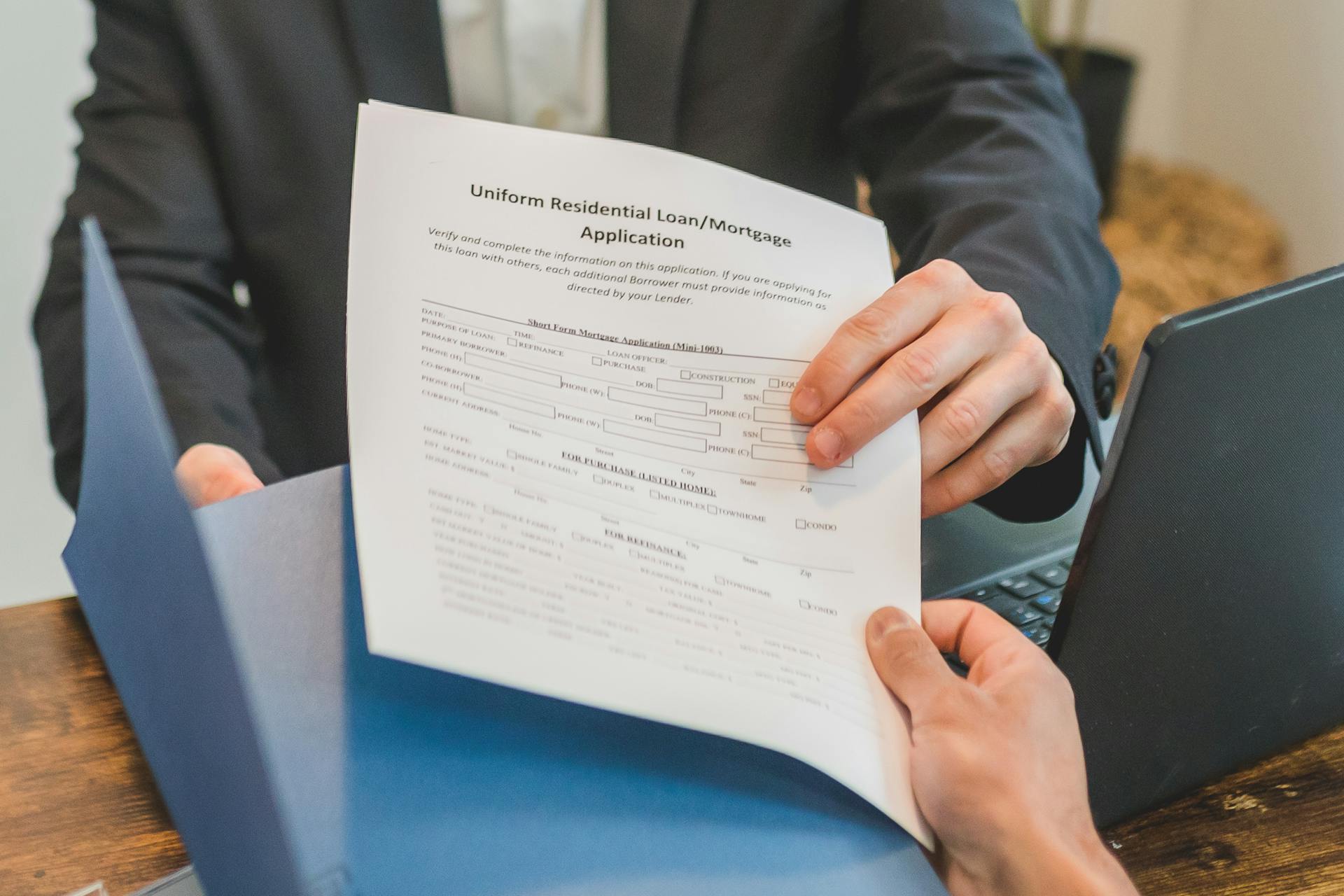
Mortgage fraud is a serious issue that can have severe consequences for individuals and the financial system as a whole. It involves intentionally providing false information or concealing the truth to obtain a mortgage or other type of loan.
The types of mortgage fraud include real estate settlement procedures fraud, which involves manipulating the process of buying or selling a home to commit fraud. This can include fake appraisals, false loan applications, and other deceptive tactics.
Mortgage fraud can also take the form of property flipping, where an individual buys a property with the intention of quickly reselling it for a profit, often by inflating the value of the property. This can lead to a false sense of security for the buyer, who may be unaware of the property's true value.
It's estimated that mortgage fraud costs the US economy billions of dollars each year, making it a significant concern for financial institutions and law enforcement agencies.
What Is Mortgage Fraud?
Mortgage fraud is a serious issue that can have severe consequences for both lenders and homeowners. It involves lying or omitting information used by a mortgage underwriter or lender to fund, purchase, or insure a mortgage loan.
Mortgage fraud can be committed by both borrowers and mortgage lenders. Industry insiders often use their knowledge to facilitate fraud, while borrowers may lie about their finances to gain or maintain ownership of a property.
There are two primary categories of mortgage fraud: fraud for profit and fraud for property. Fraud for profit is typically committed by insiders who misuse the mortgage lending process to steal cash and equity from lenders or homeowners.
A home buyer may lie about their employment status, income, property value, credit situation, or other aspects of their finances to obtain a loan approval or more favorable loan conditions. This is an example of fraud for property.
Here are the two primary categories of mortgage fraud:
- Fraud for profit: committed by industry insiders, such as bank officers, appraisers, mortgage bankers, and real estate agents.
- Fraud for property: committed by borrowers to gain or maintain ownership of a property.
Types of Mortgage Fraud
Mortgage fraud can be broken down into two categories: fraud committed by mortgage borrowers and for-profit fraud schemes that prey on borrowers. There are several types of mortgage fraud, including fraudulent property flipping and foreclosure scams.
Some common types of mortgage fraud include straw buyer schemes, where a more qualified borrower puts their name on the loan application for someone else, and foreclosure rescue and loan modification scams, where scammers target homeowners experiencing financial hardship.
Here are some specific examples of mortgage fraud:
- Straw buyer schemes: A more qualified borrower puts their name on the loan application for someone else, often to hide the real buyer's identity.
- Foreclosure rescue and loan modification scams: Scammers target homeowners experiencing financial hardship, offering to "save" their home for a fee.
- Property flipping: A property is purchased below market price and immediately sold for profit, often with the help of a corrupt appraiser.
- False identity usage: Scammers use a false or stolen identity to commit mortgage fraud, often using sensitive information like a Social Security number or pay stub.
What Are the Elements of?
Mortgage fraud can be a complex issue, but let's break down the essential elements of the crime.
The perpetrator must have acted with intent to defraud, which means they deliberately tried to deceive someone.
To be charged with wire or mail fraud, the perpetrator must have used the United States mail system or an electronic communication, such as a text message, email, or fax, to carry out the scheme.
The perpetrator must have purposefully made a misrepresentation of an important or material fact, which can be a crucial piece of information in a mortgage application.
The perpetrator must have known that the misrepresentation was false, showing a level of intent and awareness of their actions.
The misrepresentation must have been communicated to another individual who justifiably relied on that misrepresentation, which can be a family member, friend, or even a business partner.
The victim must have suffered a loss as a result of their reliance on the misrepresentation, which can be financial, emotional, or both.
Here are the elements of mortgage loan fraud in a concise list:
- The perpetrator acted with intent to defraud.
- The perpetrator used the United States mail system or an electronic communication to carry out the scheme.
- The perpetrator made a misrepresentation of an important or material fact.
- The perpetrator knew the misrepresentation was false.
- The misrepresentation was communicated to another individual who justifiably relied on it.
- The victim suffered a loss as a result of their reliance on the misrepresentation.
Different Types
Mortgage fraud can take many forms, but some of the most common types include:
Equity skimming, where investors use a straw buyer to obtain a mortgage loan in the straw buyer's name, then rent the property until foreclosure, profiting from the rental income.
Straw buyer schemes, where a more qualified borrower puts their name on the loan application for a less qualified person, often a friend or relative, to reside in the property.
Foreclosure scams, where scammers offer to "save" a homeowner's home in exchange for a fee, but the assistance is fake, leaving the homeowner at risk of losing equity or paying for fake services.
Property flipping, where a property is purchased below market price and immediately sold for profit, often with the help of a corrupt appraiser who inflates the value of the property.
These types of mortgage fraud can be committed by individuals or groups, and can result in significant financial losses for victims.
Here are some common characteristics of straw buyer schemes:
- An entity other than the borrower makes the mortgage payments
- The buyer doesn't intend to occupy the home
- The buyer isn't represented by a real estate agent
- The loan applicant's income, savings, and credit are inconsistent with their overall profile
Silent Seconds
Silent seconds are a type of mortgage fraud where the buyer gets a second loan to pay for the down payment, without disclosing it to the lender.
This second loan can make it appear as if the borrower invested their own money in the down payment, which can be misleading to the lender.
In reality, the borrower is still taking on debt, but it's hidden from the lender's view.
Why and How Mortgage Fraud Happens
Mortgage fraud happens when individuals deliberately lie or omit information to secure a loan. This can be driven by the potential for financial gain or the desire to buy a home they can't afford.
People commit mortgage fraud for various reasons, including boosting their mortgage approval odds, securing a larger home loan, getting a lower mortgage rate, obtaining better loan terms, and turning a profit quickly. In fact, some borrowers believe they're unlikely to be approved for a loan using honest information, so they misrepresent or omit relevant information.
Industry professionals commit fraud for profit by misrepresenting their clients' financial information, maximizing their profits on the transaction. This type of fraud is typically committed by insiders such as bank officers, appraisers, mortgage bankers, and real estate agents.
Mortgage fraud can be categorized into two primary types: fraud for profit and fraud for property. Fraud for profit involves insiders using industry knowledge to facilitate fraud and steal cash and equity from lenders or homeowners.
Why Commit?
People commit mortgage fraud for financial gain or to buy a home they can't afford. Common reasons include boosting their mortgage approval odds, securing a larger home loan, and getting a lower mortgage rate.
Some borrowers commit fraud because they believe they're unlikely to be approved for a loan using honest information, so they misrepresent or omit relevant information to retain their current home or obtain a new one.
Industry professionals may commit fraud for profit by misrepresenting their clients' financial information, thereby maximizing their profits on the transaction.
Beware During Closing
Wiring money for closing costs can leave you vulnerable to fraud and scams.
Mortgage wire fraud is a common tactic used by real estate fraudsters to steal your money.
You can protect yourself by verifying the wiring instructions with your lender or title company to ensure they match the information provided to you.
A scammer may pose as a representative from your lender or title company to trick you into wiring money to a fake account.
Make sure to keep all communication and documents related to closing costs secure and confidential.
Recognizing Scams
Mortgage fraud can be committed by both borrowers and mortgage lenders, and it's essential to know the signs to avoid falling victim to a scam.
A common type of mortgage fraud is falsifying information on a mortgage application, which can include leaving out information about outstanding debts or making false statements about income.
Borrowers may lie about their employment status, income, property value, credit situation, or other aspects of their finances to gain or maintain ownership of a property.
Here are some red flags to watch out for:
- False statements or omissions on a mortgage application
- Failure to disclose crucial information, such as having a second lender or a second mortgage
- Identity theft, using another person's name and information without their knowledge and consent
- Occupancy fraud, providing false information about the property's intended use
- Income fraud, making false statements about income level
- Straw buyers, allowing someone to use your identity or credit information to obtain property
These types of scams can be committed by industry insiders, such as bank officers, appraisers, mortgage bankers, and real estate agents, who use their knowledge to facilitate fraud and steal cash and equity from lenders or homeowners.
Methods of Mortgage Fraud
Mortgage fraud can take many forms, and it's essential to be aware of the common methods used to commit these types of scams.
Falsifying information on a mortgage application is one type of mortgage fraud, which may include leaving out information about outstanding debts or making false statements about income or credit card balances.
Mortgage applicants can avoid allegations of mortgage fraud by ensuring everything on their loan application is true and accurate to the best of their knowledge.
Some common types of mortgage fraud include false statements, failure to disclose, identity theft, occupancy fraud, income fraud, and straw buyers.
Here are some examples of mortgage fraud:
- False statements: Falsifying information on a mortgage application, leaving out information about outstanding debts, and other misrepresentations and omissions.
- Failure to disclose: Failing to inform a lender or concealing information about certain crucial facts, such as having a second lender or a second mortgage.
- Identity theft: Using another person's name and information without that individual's knowledge and consent.
- Occupancy fraud: Providing false information about the occupancy of the property, such as not truthfully reporting whether it is intended to be the buyer's primary residence.
- Income fraud: Making false statements about income level.
- Straw buyers: One individual allowing another to use their identity or credit information to obtain property when the buyer may not qualify for a mortgage.
False appraisals are another common method of mortgage fraud, where an appraiser inflates the value of a property to increase the purchase price and maximize their commission.
Common Ways to Commit
Mortgage fraud can take many forms, and it's essential to be aware of the common ways to commit it. Falsifying information on a mortgage application is one type of mortgage fraud.
Falsifying information about income, credit card balances, or outstanding debts on the mortgage loan application is a red flag for mortgage fraud. Failing to disclose crucial facts, such as having a second lender or a second mortgage, is also a form of mortgage fraud.

Identity theft occurs when someone uses another person's name and information without their knowledge and consent. Occupancy fraud involves providing false information about the occupancy of the property, such as not truthfully reporting whether it's intended to be the buyer's primary residence.
Inflated appraisals are another common method of mortgage fraud, often committed by corrupt appraisers who undervalue a property to ensure an investor can purchase it or inflate the value to increase the purchase price and maximize their commission.
Here are some common types of mortgage fraud:
Asset rental fraud occurs when loan applicants borrow or rent the assets of others to make themselves appear more qualified for mortgage financing.
Reverse Scams
Reverse Scams can be particularly devastating for older Americans who are trying to tap into their home equity. Reverse mortgage scams involve scammers tricking homeowners to take out a reverse mortgage, and then stealing the funds.
Reverse mortgages are specifically designed for Americans 62 and older, allowing them to access the equity in their homes. Unfortunately, this creates opportunities for fraudsters to target vulnerable individuals.
Detection Methods
Lenders have a strong motive to detect mortgage fraud, as they lose money if a home buyer doesn't make payments due to misrepresentation of their finances.
Lenders use various methods to detect mortgage fraud, including checking loan applications for red flags such as spelling errors and inconsistencies with the borrower's income.
Many lenders also use fraud detection software, such as CoreLogic's LoanSafe, to help identify potential fraud.
Lenders may also investigate if a borrower misses payments, which can be a sign of mortgage fraud.
To ensure legitimacy, lenders cross-check the information you submit in the loan application process with other available sources.
Lenders may analyze documents to see if there is evidence they've been doctored or modified, which is a common sign of mortgage fraud.
Local or federal government agencies can also detect mortgage fraud, often working with lenders to uncover instances of fraudulent activity.
Frequently Asked Questions
What is an example of loan fraud?
Loan fraud can occur when someone steals another person's identity or misrepresents their own financial information on a loan application. This can include lying about income, address, or other requested details to secure a loan.
What happens if you get caught mortgage fraud?
If caught, mortgage fraud can result in severe penalties, including up to 30 years in federal prison and $1 million in fines. Those convicted may face serious consequences, making it essential to understand the risks and avoid engaging in mortgage fraud altogether.
Featured Images: pexels.com


